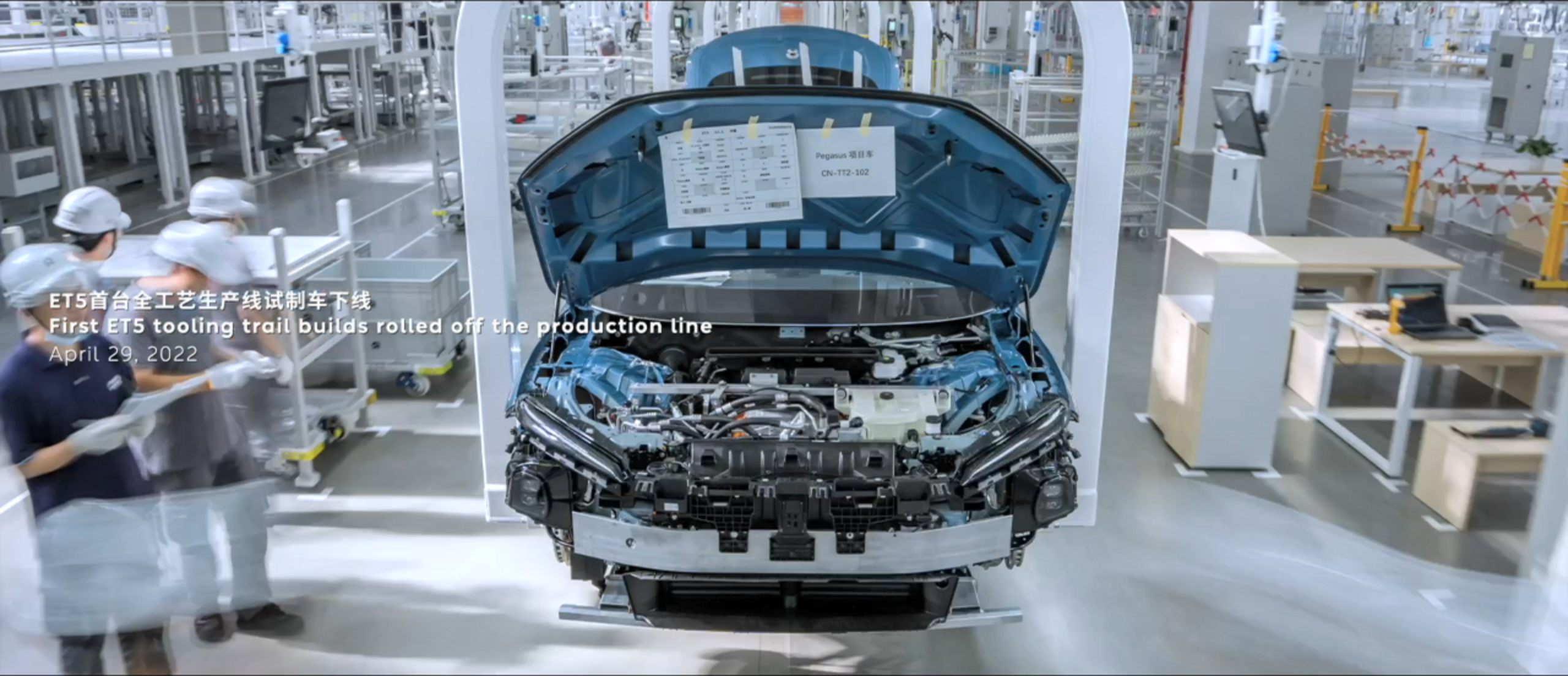Today, let’s take a look at the official hardware configuration “spoilers” for the ET5~
These are the official “leaks,” and I’m just the “transporter” of the materials. First, some small talk, and then let’s get to the goods~
The ET5, which had a pre-subsidy price of 328,000 yuan, no longer has the design of the previous model’s white body high-aluminum alloy, but instead has a gradually “Model 3”-style (steel-aluminum mix) body. Is it worth it or not?
Uh, look at the position of the door-opening button and the shape of the rearview mirror… It seems “special”~
The Tesla Model 3 has gone up to 279,900 yuan, so I’ll give you 100 yuan to make it an even 280,000 yuan, with a CLTC range of 556 km.
The ET5 sells for about 328,000 yuan, or about 316,000 yuan after subsidies. The standard 75kWh battery pack has a CLTC range of 560 km (with 19-inch wheels) or 500 km (with 20-inch wheels for an extra 9,500 yuan). The battery can also be upgraded to a 100kWh battery pack, which has a range of 710 km / 640 km. The battery can also be continuously replaced. Can you handle upgrading from a small battery to a large one in the future?
Actually, there is still a “sea lion” watching these two competitors closely in this red ocean.
Honestly, maybe when the sea lion jumps out of the water, these two won’t have anything left to do…
Now there’s a new “peng” (referring to NIO) friend, the G9 with an 800V high-voltage silicon carbide platform. Although it’s not the same type of car, just comparing the platform and design, are you worried or not?
In the video “NeoPark Rises in 150 Seconds,” there is information about the hardware configuration of the ET5 on the production line. (Front longitudinal beam, front energy absorption box, whether it is aluminum or not, whether there is a front trunk/back trunk, front/rear suspension, front/rear subframe)
This picture is so cool! Look, there’s a big gray plane in the upper left corner!!!
Okay, let’s continue~
The front longitudinal beam is made of steel, which is a bit disappointing~
The Torque Box has also changed from aluminum to a steel reinforcement similar to that of the “3”.
But the “3” also uses this design, which achieves various safety collision ratings of 5 stars, so there’s no need to criticize the design of the ET5. After all, the cost is there~
ES, EC, and ET7 have this big Torque Box and large aluminum longitudinal beam, which has truly made several of the competitors here green with envy!!!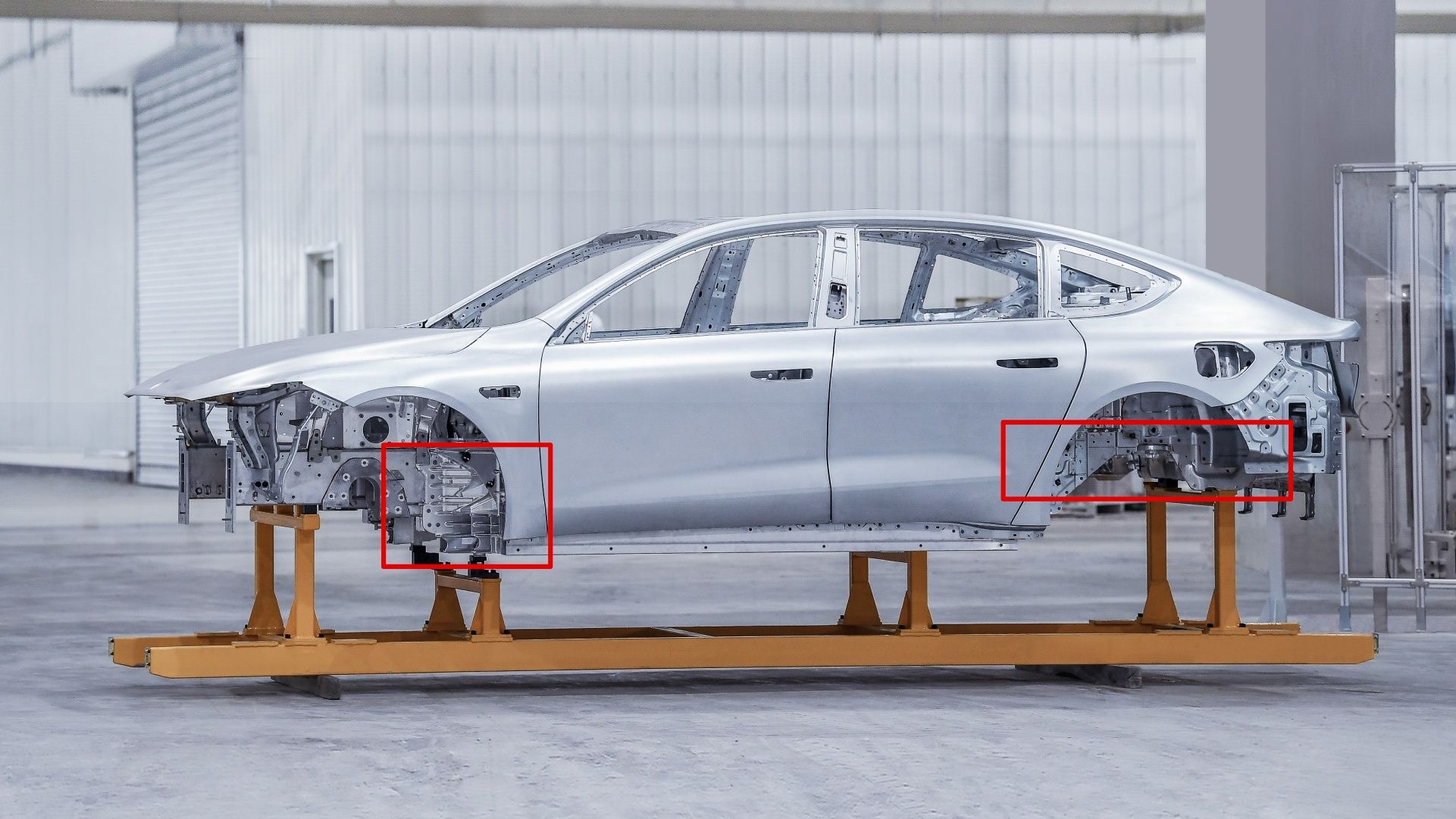
However, there is no integrated casting part on the rear of the ET7, which is exclusive to the ET5, yay!~


The integrated casting part at the rear of the car is not as large as that on the Model Y, but its first-time use is commendable!!!
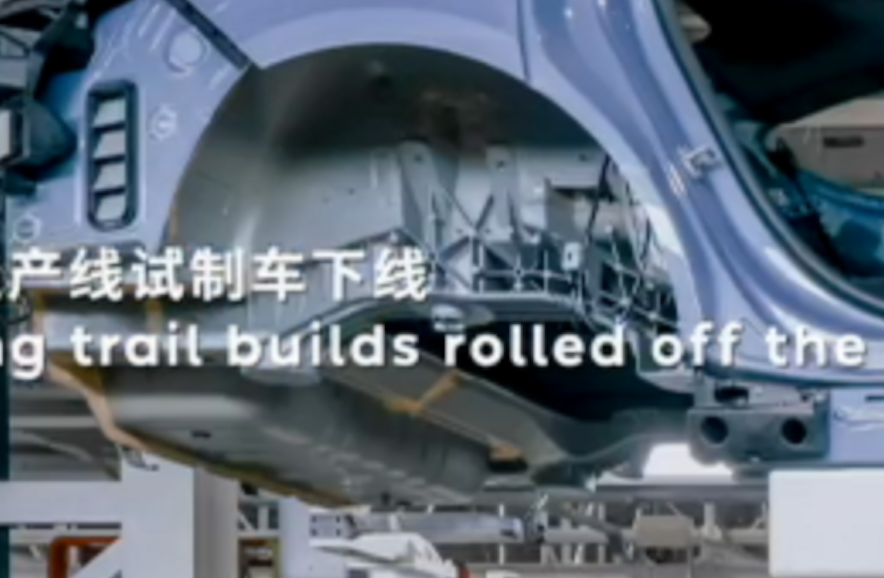
There is a large space, possibly a rectangular space similar to the “3” trunk under the trunk of the ET5. See the pictures above and below~

Like the current models on sale, the firewall does not reserve the position of the steering column for right-hand drive models. It should be that right-hand drive models have not been considered for the time being.


The section of the front longitudinal beam is in a “sun” shape, which is weaker than the “field” shape of the Model 3!!!

It is also weaker than the “aim” shape of the ES and EC series, and the ET7!!!

The originally separate plastic water tank frame is now integrated with the metal part on the longitudinal beam~

The front subframe is made of steel, consistent with the current models on sale. This may be due to cost considerations, because twenty years ago, the front subframe was made of aluminum. However, for the “3”, the front subframe has always been made of steel. There is no need to criticize the “cost reduction and efficiency increase” since NIO is also here to make money~
 # English Markdown
# English Markdown
The rear subframe continues NIO’s generosity, and the whole thing is a large cast aluminum piece!!!

Want to hit someone, still no frunk!!!

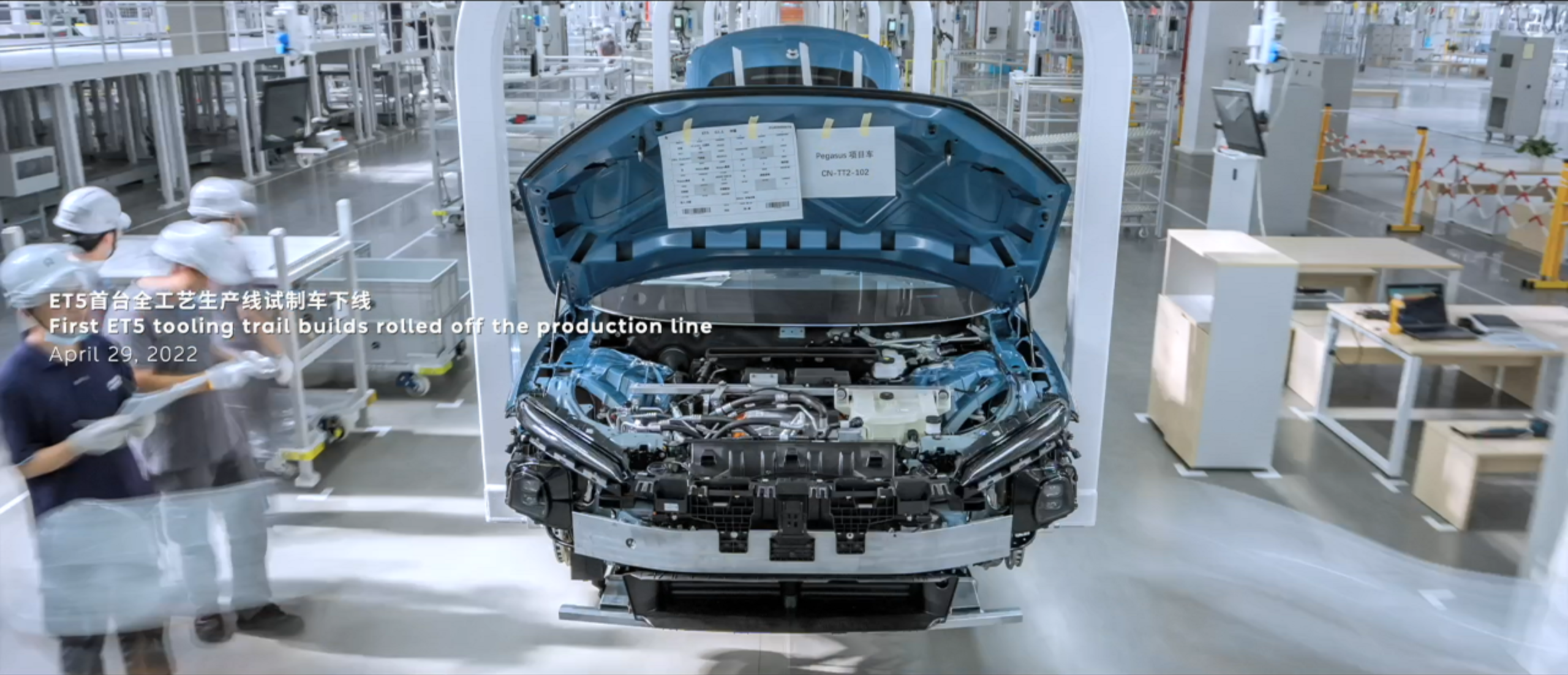
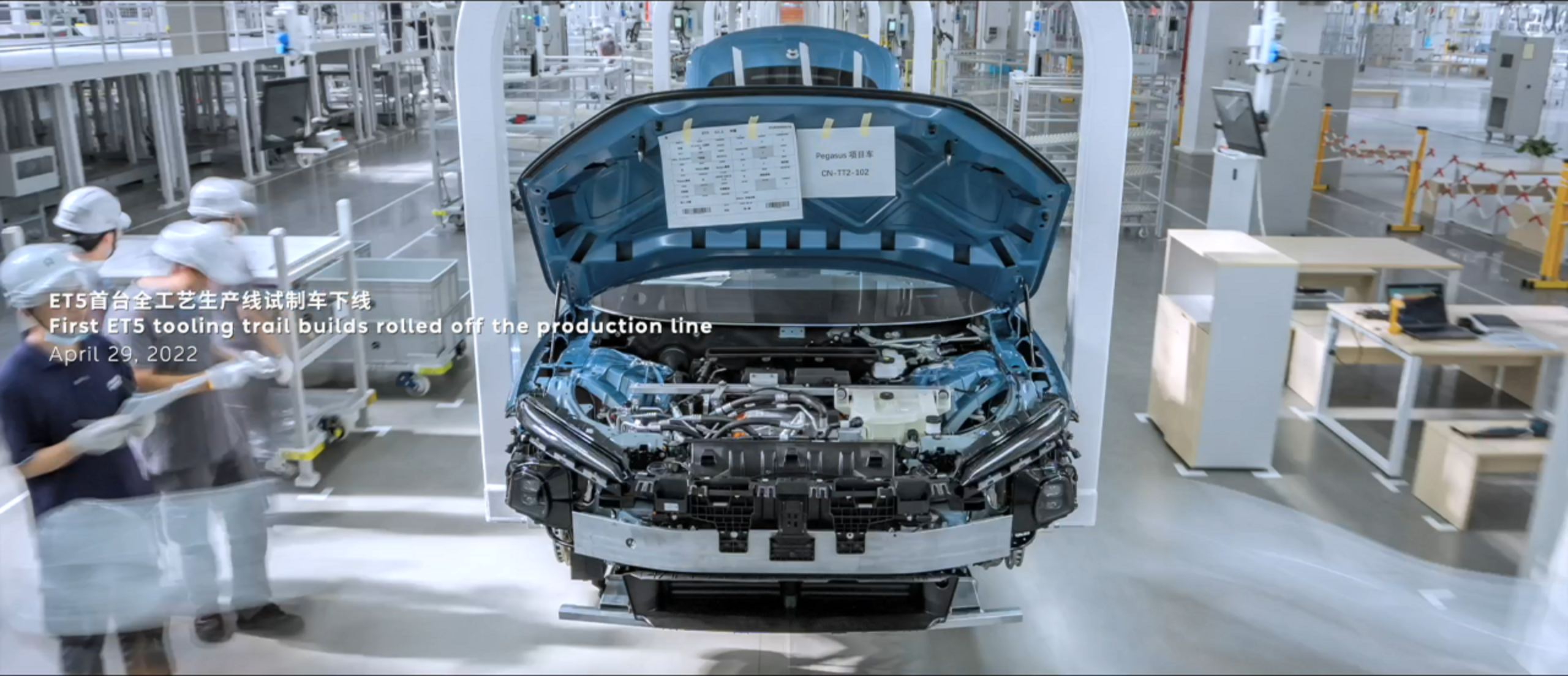
When I saw the “messy” pipeline of the thermal management system, I realized that we could learn from Tesla’s Super Manifold and Octovalve, or at least learn from the Ford Mustang Mach-E. Although the pipeline is “messy”, they can still make room for a frunk~


This is something NIO deserves to be criticized for- why didn’t they think of adding a frunk? It’s such a simple idea!
Have you flunked out of learning?
Competitor- Tesla Model 3
The price of the Model 3 will drop to around 240,000 yuan, I’m telling you this, and I’m putting it on the table!!!!
In comparison:
Model 3 weight: 1761kg (RWD), 1836kg (AWD), 4694×1850×1443, wheelbase of 2875, drag coefficient of 0.23Cd
ET5 weight: 2145kg, 4790×1960×1499, wheelbase of 2888, drag coefficient of 0.24Cd
The ET5 is 9.6cm longer, 11cm wider, and 5.6cm higher than the Model 3.
What really stunned me was that the ET5’s net weight is heavier than the AWD Model 3 by 309kg and heavier than the RWD Model 3 by 384kg!!!
Sandy Munro once said, “Every engineer should think every day about how to make the vehicle lighter by 1g!!!”
This weight problem is not the fault of any one person, but rather an accumulation of each system’s lack of attention to weight reduction- each department at NIO should send a representative to receive punishment!!!The width of the car body does not include the rearview mirror, and it is 11cm narrower which is not surprising. Because the battery pack size of “WW” limits the overall vehicle size, in order to consider battery swapping, compromises can only be made on the width of the car body, similar to other major models.
However, this also has its benefits, as the interior space of the “WW” horizontally is very spacious.
This also makes the “WW” looks a bit “inconsistent” from a certain angle, with a slightly flat and wide front.
2) The $280,000 “3” is a single-motor rear-wheel drive. I don’t really want to talk about this, as most of the operating conditions of “WW” should rely on the rear permanent magnet motor drive. Running with an additional motor will indeed increase energy consumption and cost to NIO. However, Bin Ge once said that “NIO does not make single-motor cars.” If a single-motor vehicle is released, it will be contradictory. However, from the perspective of cost, it is feasible to produce one. Maybe this task will be entrusted to a “sub-brand” to complete.
3) A comparison of the body structure of “WW” production line video screenshots and “3” shows that Tesla’s front longitudinal beam is slightly better in a “T” shape.
4) At present, the advantages of “charge and swap integration” are still obvious, especially in high-speed driving. However, the disadvantage is that after the inventory is high, there will be a queue for battery swapping during holidays (refer to the analysis of the queue situation of BAIC’s electric taxi battery swapping in Beijing, which uses Austrian new energy battery swapping station whose battery pack is not liquid-cooled and has faster swapping speed. It takes about 4 minutes to replace once at the latest and fastest station in Beijing. It may be common to queue for 30-40 minutes during peak periods). NIO’s second-generation battery swapping station (13 batteries) takes a total of 6 minutes+ to replace, and waiting times will also increase by 30% under the same conditions, possibly up to 1 hour (of course, this only happens when the inventory is very high and services are concentrated at service areas during holidays), if a first-generation swapping station (5 batteries) is encountered, it may encounter the embarrassing situation of “no more batteries to swap”!!!
The deployment strategy of “charge and swap integration” should be strengthened, especially in the service area of first-generation swapping stations of highways!!!
5) Tesla’s V3 Supercharging is indeed fast, and it can charge at a power of over 100 kW for a period of time. Below is the charging speed of LG and Panasonic’s ternary lithium-ion battery Model 3 on V3 Supercharging newly tested by Xinchu.
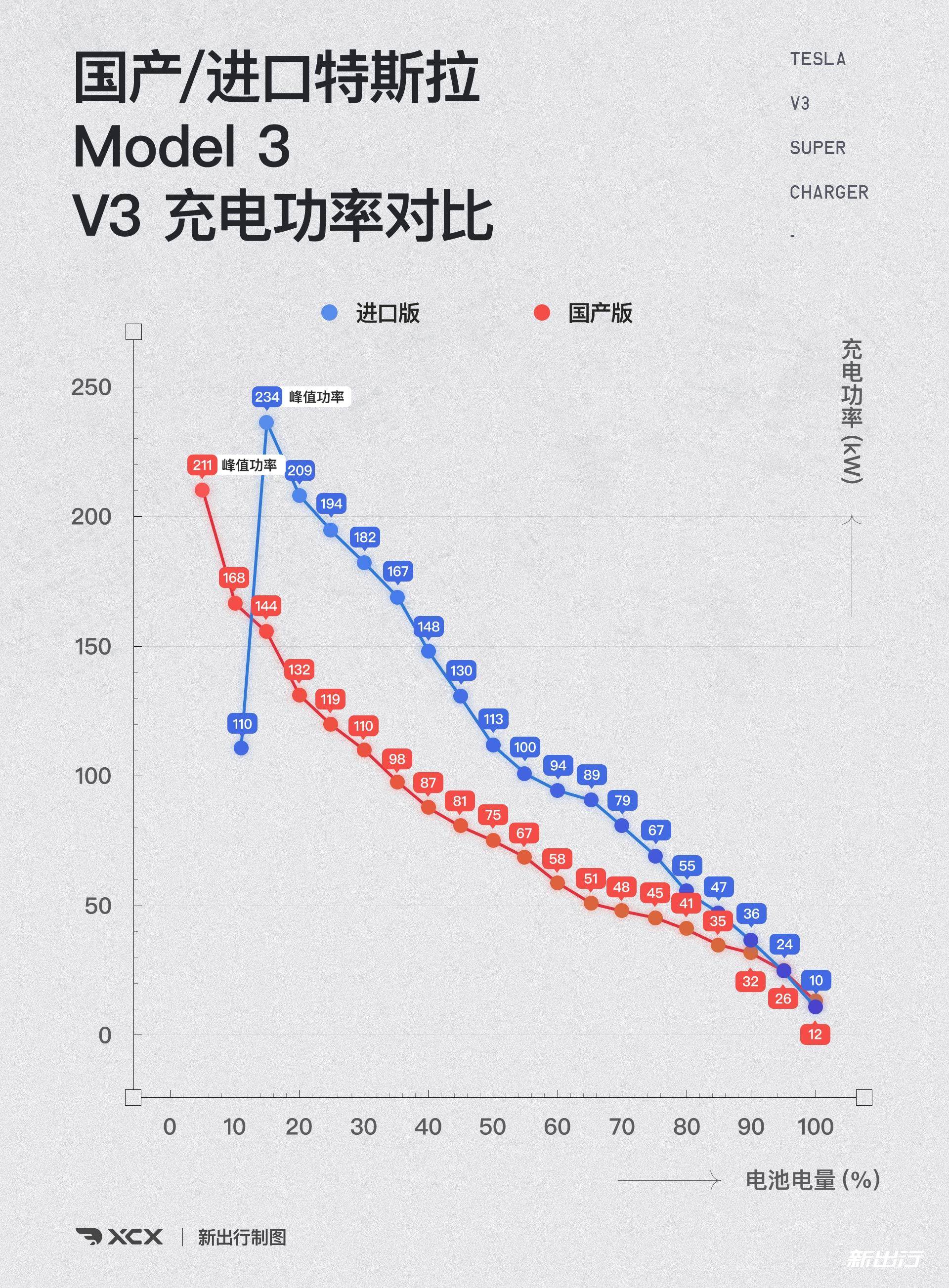
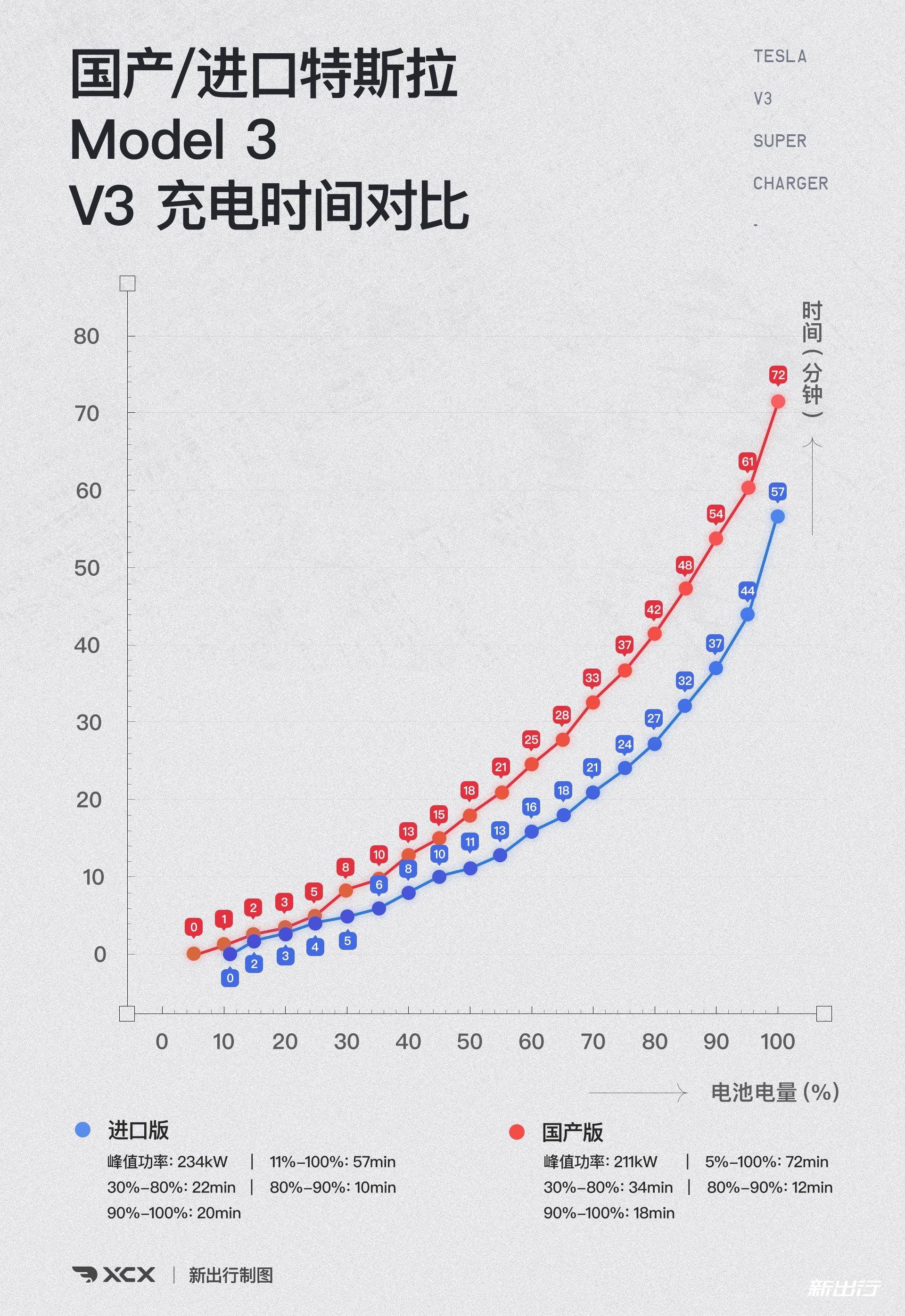
The following is the charging speed of the iron-lithium phosphate battery Model 3 tested by Garage 42 on V2 Supercharge.
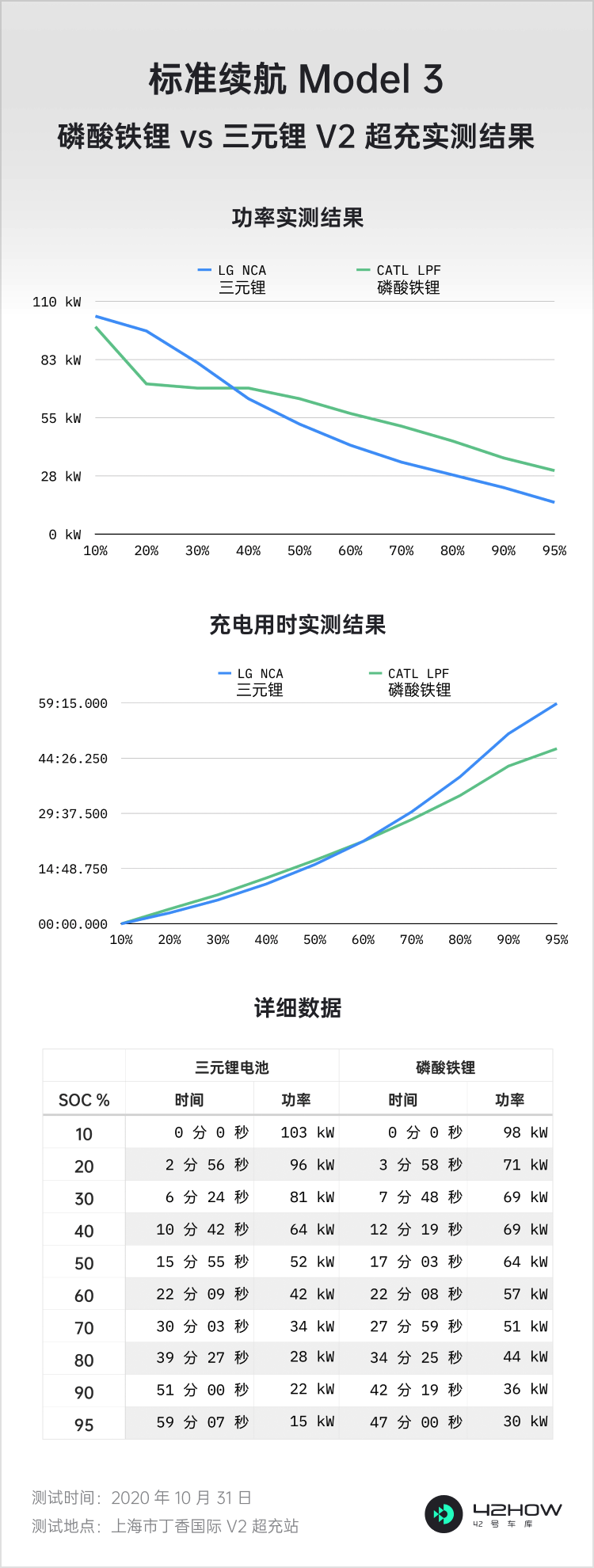
The charging power of iron-lithium phosphate Model 3 is still greatly affected by the cold.Currently, NIO’s models, such as the ET7, have opened up their charging capabilities with peak charging power of around 110kW, but there is still room for improvement. However, Tesla’s Supercharger stations are rare in service areas and their compatibility with State Grid charging stations is not very good. The safest option when traveling long distances is to exit the highway and find a Tesla Supercharger, although the time consumed due to the round trip cancels out the advantage of fast charging speed.
6) “55” LiDAR + vision for NIO, while Tesla relies solely on vision, but FSD is still a futures contract. After all, Elon Musk is the best at making promises that are too big and too good to be true!!! Besides, FSD will inevitably face problems in China due to differences in environment and driving habits. I am more optimistic about domestic manufacturers’ solutions, which combine vision, LiDAR, and high-precision maps. Huawei’s solution is currently too expensive, but “friends of Peng” who understand intelligent cars in China showcase their various city NGP functions and inter-floor memory parking in parking lots, which is impressive~
NIO is estimated to lag behind “friends of Peng” by half a year to a year in this aspect~
7) Chargets are not included for free with Teslas, so you have to pay another 8000 yuan for them. NIO is more considerate, providing free chargers and installation, as well as four free battery swaps per month. If you don’t have a charger, you get six free battery swaps per month. So how can this company make any profit?
8) “55” provides a ten-year unlimited mileage warranty, while the “3” has a four-year or 80,000-kilometer vehicle warranty, and an eight-year or 160,000-kilometer battery and drive unit warranty. However, under normal use, it is likely that the car will be replaced within ten years, and it is unlikely that it will be driven for over 160,000 kilometers.
But for Teslas, if any parts are damaged after the warranty period, the owner will have to pay for the replacement themselves. After all, the high cost of repair and parts for Teslas is well-known, and the difference is clear!
BYD Han
With subsidies, the price of “Bao Bao” is between 209,800 and 286,800 yuan. Rather than being a “55” alternative, she is a formidable competitor to become the “3” with a price that will fall to 240,000 yuan in the future.
1) First of all, having a front trunk is a matter of “attitude”. Although “Bao Bao” is not as large as the “3”, it does not neglect storage space, but provides more storage space for consumers by integrating the front compartment parts with smaller designs.
NIO lacks this kind of “attitude”. “What’s the point of having a low utilization rate of the front trunk? We are considering it for the users. If it gets dirty from opening and closing… “I don’t want to hear it. If there is none, there is none. When the car is filled with things that have nowhere else to go, then we’ll see what you have to say! Perhaps by reusing some components from its predecessors, NIO can create more space in the front compartment.
2) Electric drive boost charging, which is amazing. By using the components of the electric drive system directly for charging and not adding more electronic components, the charging power can reach 150kW. This is called “smart”! NIO, take note!
3) “Bao Bao’s “CTB” is highly praised by the new Tesla Model Y. Good job, you have learned from me thoroughly, you are capable. You are really “criminal”!4) “Leopard” offers lifetime warranty for the three-electric system (for the first owner) and 6-year/150,000-kilometer warranty for the entire vehicle. However, the lifetime quality warranty for the three-electric system requires periodic maintenance every 12 months and mileage less than 30,000 kilometers. Oh, you missed it.
5) The weight of “Leopard” is 1885kg/2015kg (single motor rear-wheel drive) and 2150kg (four-wheel drive), with a size of 4800mm x 1875mm x 1460mm and a wheelbase of 2920mm. It can accelerate from 0 to 100 km/h in 3.8 seconds (four-wheel drive)/5.9 seconds (long-range rear-wheel drive)/7.5 seconds (standard-range rear-wheel drive) with a drag coefficient of 0.219Cd. “Five-five” weighs 2145kg, with a size of 4790mm x 1960mm x 1499mm and a wheelbase of 2888mm. It can accelerate from 0 to 100 km/h in 4.3 seconds with a drag coefficient of 0.24Cd.
Both four-wheel drive versions of the two cars have similar weights, but “Leopard” is 5kg heavier. You can’t buy a pig in a poke even if it’s not expensive. By the way, “Leopard” has a battery capacity of 82.5kWh, which is 7.5kWh more than “Five-five”. Is this the advantage of CTB technology in terms of weight?
However, both cars are about 380kg heavier than the “Model 3” with a single electric motor and rear-wheel drive using a 60kWh battery pack, or about 300kg heavier than the “Model 3P” with a four-wheel drive using a 78.4kWh battery pack. The weight reduction aspect is really different!
“Leopard” is 8.5cm narrower and 3.9cm lower than “Five-five”, but its wheelbase is 2.2cm longer.
6) The iTAC intelligent torque control system is awesome, although it is only available for the four-wheel drive version. Does it mean that you have to buy the most expensive one to equip it?
7) “Leopard” also comes with a charging station, but you have to install it within two years of purchasing the car, no exceptions.
8) The center console screen of “Leopard” can rotate, which is really cool. You can adjust it to be vertical or horizontal, whatever you want, just do it! However, the system UI is really not good, it seems like an Android tablet from years ago. There is still a big gap between new automakers like NIO and others in terms of intelligent cockpit and automatic driving assistance!
“Pseudo” competitor XPeng G9
Although it also needs to be compared with ES7, in terms of platform, electronic and electrical architecture and design, to be honest, G9 is one generation ahead of the cars currently on sale by NIO.
1) The 800V high-voltage silicon carbide platform can charge 200 kilometers in 5 minutes. At the S4 ultra-fast charging station of XPeng’s 1,000th self-operated charging station, the peak charging power of G9 reached 440 kW+, and the overall power during the 5-minute charging process was also over 300 kW, which is really amazing! Tesla’s V3 supercharger with 250 kW and Lucid Air’s fast charger with 350 kW were instantly surpassed, causing countless competitors to bow down!1. However, Yitong student claimed that their pure electric platform can charge 400 kilometers in 10 minutes in the lab. You must be here to stir up trouble. Why don’t you wait until you actually produce a pure electric car before playing with “Peng friends”?
-
X-EEA 3.0 electronic electrical architecture enables OTA system upgrades while driving. Can you handle it?
-
Air suspension and two laser radars at the front of the car, looking forward to your city NGP performance.
-
Just received some new information (Han Lu’s static review data) – G9’s four 360-degree surround view cameras have a resolution of 1.3 million pixels!!!
Assisted driving cameras: cameras for side front view under the two rearview mirrors are 3 million pixels (it doesn’t mention the pixel of the side rear view camera on the fender. If the side front view is 3 million, the side rear view should also be 3 million pixels, but I still think it’s possibly that Professor Han gave the wrong data. After all, the cameras should all be 8 million pixels! The seven 8 million pixel cameras for assisted driving (“55”) are even more impressive!), and two 8 million pixel cameras are located at the front windshield position, and there is one 1.7 million pixel rearview camera at the rear of the car.
- XPeng’s surround sound voice recognition is the second to none, and no one dares to say they are the first!
“Peng friends”: “Everyone here is younger brother, yes, I’m talking about each and every one of you!”
-
28 speakers, 2250W power, 7.1.4 Dolby panoramic sound, Danas sound system, generous and domineering.
-
Two horizontally placed large screens in the center console, very comfortable for watching videos.
“55” has a screen that is close to square, which makes people angry. Don’t use regulatory level to talk about it. Full-screen video playback is the “way of the king”!
However, the interior designs of “Peng friends” are all different…
NIO has successfully continued its “tradition” in design, but it has somewhat departed from the convenience of “mass” use. It seems that inheriting “tradition” is a double-edged sword, a double-edged sword!
-
The regret of XPeng is that they don’t design and produce motors themselves. NIO is one step ahead, having already produced its 500,000th electric drive system, NIO Power, which is impressive!
-
“Peng friends” no longer provide home charging piles, and the 7kW home charging pile costs 5,000 yuan, while the 11kW home charging pile costs 7,000 yuan. Poor rating!
What is it that makes “55” so special?
- Battery swapping must be the first, without it, these three cars might be able to persuade ET5 to quit directly. It can quickly replenish energy, and there are also four or six free battery swap opportunities every month, which cannot be compared with other cars at present.
Moreover, at this stage, there is nothing more time-saving and convenient than battery swapping for long-distance travel (as long as there is no queue for swapping at service areas on highways). It is not very realistic to have a large number of “Super Charging Stations” entering service areas in a short period of time, and it will take time for “Peng friends” to do so as well.So far, the best experience for long-distance driving is NIO’s battery swapping, no doubt about it!!!
Now NIO’s battery swapping network has been built in the 5 north-south and 3 east-west metropolitan areas, and we are looking forward to the early completion of the battery swapping network in the 9 north-south and 9 east-west 19 major city clusters!!!
2) Standard automatic driving assistance hardware: laser radar, 5 millimeter wave radars, 7 cameras with 8 million pixels each… Absolutely conscientious!!!
NAD is subscribed on a monthly basis, but it comes standard with turn signal lane change, ACC, LCC, which are the basic functions of Tesla’s AP system, and also comes with turn signal assisted lane change. There probably won’t be too many NAD subscribers in the later period, as these standard functions are basically enough. I worry about whether NIO can recover the cost of the hardware!!!
3) The size is 4790×1960×1499, and the battery swapping has limited its width, which is 6.5 cm wider than “Leopard” and 11 cm wider than “Model 3.”
It is 8.5 cm longer than “Leopard” and 9.6 cm longer than “Model 3”.
It is 3.9 cm higher than “Leopard” and 5.6 cm higher than “Model 3.”
The wheelbase is 2.2 cm shorter than “Leopard” and 1.3 cm longer than “Model 3”.
The drag coefficient of “ET5” is 0.24Cd, “Leopard” is 0.219Cd, and “Model 3” is 0.24Cd.
In terms of weight, it’s basically the same as “Leopard,” both have four-wheel drive, and it’s 300kg heavier than “Model Y,” which is…
4) Electric suction door, frameless door, 7.1.4 immersive sound system (23 speakers, Dolby panoramic sound) with a power of 1000W. Adding a comfortable package of 9,500 yuan gets you front seat massage ventilation, heated steering wheel, rear seat heating, and fragrance… If you don’t choose this, you’ll really miss out!!!
5) Although there aren’t as many aluminum parts on it as the “big brother” has–front longitudinal beam, TorqueBox, “ET5” would still perform similarly well in crash tests, after all, “Model 3” has received five-star ratings in various crash tests, which has already been proven!
6) The powerful performance goes without saying. The acceleration is 4.3 seconds per hundred kilometers, and NIO has always been “conservatively estimated,” so it’s estimated that it can actually reach 4 seconds even. “Leopard” is 3.8 seconds with four-wheel drive, “Model 3” rear-wheel drive is 6.1 seconds, and “Model 3 Performance” is 3.3 seconds.
“ET5” should have similar actual test results to “Model 3 Performance,” stay tuned~
7) It’s hard to justify the lack of a front trunk, so we hope the next model can consider adding one!!! (NIO, you see my three exclamation marks, feel it!!!)
8) “ET5” is NIO’s first model with a rear integral casting, although it’s not as big as the “Model Y,” the attitude is there, and this deserves applause!!!
9) In terms of energy consumption, the 210kW permanent magnet rear motor may also use silicon carbide power modules, and can compete with “Model 3” under normal circumstances. However, with the weight of the car, it’s difficult to win…10)This ecosystem being built by Nio (App, services, Nio Center), has absolute advantages compared to other car companies, in terms of user services, user stickiness, and sense of belonging!!!
What do you think? Do you think the ET5 is worth the rush?
Anyway, I still think it’s worth it!!!
But victory always belongs to those who wait for better technology, better configuration, and longer endurance.
But shouldn’t we be living in the moment ~
When the flowers are blooming, we should pick them instead of waiting, or they will wither in vain ~
Go~~Go~~Go!!!
This article is a translation by ChatGPT of a Chinese report from 42HOW. If you have any questions about it, please email bd@42how.com.
